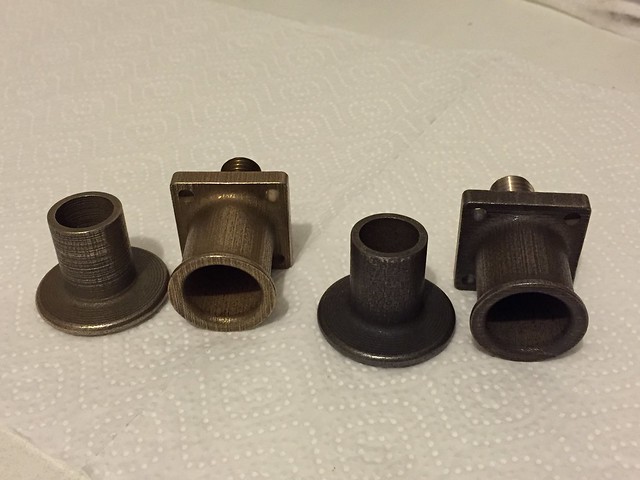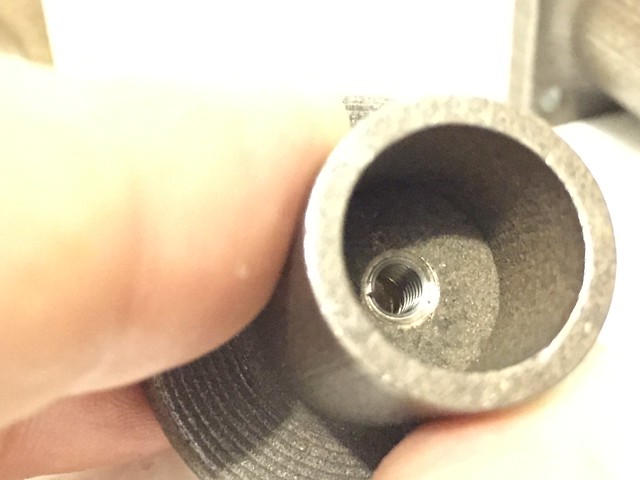Post by joanlluch on Aug 28, 2015 20:12:36 GMT
Hi All,
I wanted to bring this thread to life again for a while because I have some news with regard to the parts I had directly printed by ShapeWays.
To put this in context again:
One month ago I ordered some 3D Printed parts in stainless in order to check whether the technique was suitable for making complicated ones which otherwise would be difficult to make using conventional subtractive techniques.
One goal of my test was to check whether direct printed parts were (1) strong enough for use in mechanical parts, and (2) whether they could be further machined to get them to perfect accuracy. One possible scenario for my particular case was to make my locomotive cross-heads as 3D printed parts.
The parts I used for testing (loco buffers) were very strong, so they were ok as per (1), but unfortunately they were too strong for any subsequent mechanical operation on them, so (2) was not met. This implied that direct 3D printing was not suitable for parts that required further machining or work.
I have now decided to give it another round and decided to bring the parts to thermal treatment in order to anneal them. The parts were made off 60% 420 stainless steel powder and then infused in melted bronze at high temperature. I got the suspicion that after the parts are soaked in bronze they are just brought to quickly cool in air. So that might explain why they are so hard. 420 Stainless steel does harden. So subjecting them to Annealing should (possibly?) make them softer.
The following picture shows a set of them before (left) and after (right) annealing
 Topall Revingut by joan lluch, on Flickr
Topall Revingut by joan lluch, on Flickr
Apart from a very noticeable colour change, I found that the annealed parts (at right) did actually reduce hardness significantly and were more workable.
As supplied by ShapeWays (left) it was very difficult to drill a hole in them, and it was not possible to make a thread on them. After the thermal process (right) a thread was attempted and it was relatively easy to perform using a sharp new tap. See this:
 Topall Revingut by joan lluch, on Flickr
Topall Revingut by joan lluch, on Flickr
This means that directly printed metal parts can be optionally machined if they are subjected to an annealing thermal treatment. This was suggested elsewhere but I didn't find a clear confirmation of it actually working before.
That's good news because this opens the interesting opportunity of making complicated single parts, which can me machined, which still keep a high mechanical strength, and without having to follow the route of wax printing, moulding, and casting.
I wanted to bring this thread to life again for a while because I have some news with regard to the parts I had directly printed by ShapeWays.
To put this in context again:
One month ago I ordered some 3D Printed parts in stainless in order to check whether the technique was suitable for making complicated ones which otherwise would be difficult to make using conventional subtractive techniques.
One goal of my test was to check whether direct printed parts were (1) strong enough for use in mechanical parts, and (2) whether they could be further machined to get them to perfect accuracy. One possible scenario for my particular case was to make my locomotive cross-heads as 3D printed parts.
The parts I used for testing (loco buffers) were very strong, so they were ok as per (1), but unfortunately they were too strong for any subsequent mechanical operation on them, so (2) was not met. This implied that direct 3D printing was not suitable for parts that required further machining or work.
I have now decided to give it another round and decided to bring the parts to thermal treatment in order to anneal them. The parts were made off 60% 420 stainless steel powder and then infused in melted bronze at high temperature. I got the suspicion that after the parts are soaked in bronze they are just brought to quickly cool in air. So that might explain why they are so hard. 420 Stainless steel does harden. So subjecting them to Annealing should (possibly?) make them softer.
The following picture shows a set of them before (left) and after (right) annealing
 Topall Revingut by joan lluch, on Flickr
Topall Revingut by joan lluch, on FlickrApart from a very noticeable colour change, I found that the annealed parts (at right) did actually reduce hardness significantly and were more workable.
As supplied by ShapeWays (left) it was very difficult to drill a hole in them, and it was not possible to make a thread on them. After the thermal process (right) a thread was attempted and it was relatively easy to perform using a sharp new tap. See this:
 Topall Revingut by joan lluch, on Flickr
Topall Revingut by joan lluch, on FlickrThis means that directly printed metal parts can be optionally machined if they are subjected to an annealing thermal treatment. This was suggested elsewhere but I didn't find a clear confirmation of it actually working before.
That's good news because this opens the interesting opportunity of making complicated single parts, which can me machined, which still keep a high mechanical strength, and without having to follow the route of wax printing, moulding, and casting.




